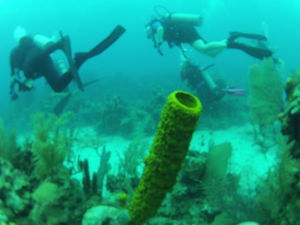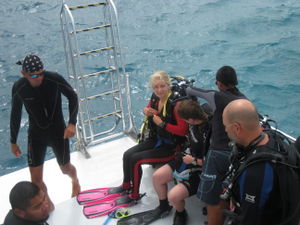Pharmaceuticals: Difference between revisions
| Line 55: | Line 55: | ||
== '''A Promise Lost?''' == | == '''A Promise Lost?''' == | ||
''“In the absence of effective management of coral reefs and the resources they contain, many species that are promising as new sources of biochemical materials for pharmaceuticals and other products may be lost before scientists have the opportunity to evaluate them”'' (Bruckner). | ''“In the absence of effective management of coral reefs and the resources they contain, many species that are promising as new sources of biochemical materials for pharmaceuticals and other products may be lost before scientists have the opportunity to evaluate them”'' (Bruckner)<ref name="Bruckner" />. | ||
The need for conservation of coral reef ecosystems requires immediate action and more than what is now being done. Many seahorse populations, mostly used for traditional medicine in Eastern countries, are being rapidly depleted as demand for seahorse in traditional medicine grows. Seahorse populations declined by 50 percent worldwide between 1990 and 1995 (Bruckner). | The need for conservation of coral reef ecosystems requires immediate action and more than what is now being done. Many seahorse populations, mostly used for traditional medicine in Eastern countries, are being rapidly depleted as demand for seahorse in traditional medicine grows. Seahorse populations declined by 50 percent worldwide between 1990 and 1995 (Bruckner)<ref name="Bruckner" />. | ||
= ''Notes'' = | = ''Notes'' = | ||
Revision as of 16:29, 27 February 2013
Reefs and Pharmaceuticals
Corals that Cure
“The prospect of finding a new drug in the sea, especially among coral reef species, may be 300 to 400 times more likely than isolating one from a terrestrial ecosystem” (Bruckner)[1].

Oceans contain over 80% of the biodiversity on earth. 40-50% of our pharmaceuticals come from natural resources, mostly terrestrial and often found in rainforests (Bruckner) [1]. Coral reefs, the rainforests of the ocean, are even more likely to hold the next cure or drug resource.
Reefs Used for Traditional Medicine
As early as the 14th century Eastern cultures recognized beneficial properties of coral reef ecosystems (Bruckner) [1]. One example is the use of seahorse extracts in China, Taiwan, and Japan for sexual disorders, pain, skin problems, kidney and liver diseases, circulatory and respiratory problems (Bruckner) [1]. Using reef organisms for their medicinal properties even traces back to the times of Hippocrates and Plato in the west. Hippocrates and Plato believed snail mucus helped with pain relief “related to burns, abscesses, and other wounds” (Bonnemain 25) [2]. Snails have continued to be used to help with various medical problems, including for external dermatological use in the 18th century (Bonnemain 25) [3].
Diseases that Reefs Hold Potential Cures for Today
Bacterial Diseases
Peter Moeller from NC State University recently discovered a sea sponge that naturally fights off bacteria in its natural state in the ocean and that could possibly be used to fight infectious diseases that have become antibacterial resistant like MDR-Tuberculosis (Lebwohl).
Inflammatory Diseases
Pseudopterosins, a class of natural products, come from coral and have anti-inflammatory and analgesic properties. It was found and is now used in skin care products, including products by Estee Lauder (Bruckner)[1].
Arthritis
Asthma
Bone Diseases
Bone grafts are often created from corals. Using coral as bone grafts is innovative and has become a necessity because important autologous bones are limited and the bone grafting procedure has corals are very permeable which mean that the mortality rate in the procedure is lowered because the coral has more of a chance of being tolerated by the body. Recently, a new coral bone graft was created that replaces a bone and then helps that bone regrow together before dissolving (Wu).
Cancer
At least a dozen compounds that come from marine sources are in trial for use as anticancer agents that could cure breast cancer, liver cancer, and leukemia (Moldofsky).
Heart disease
Other Uses of Coral
Labor pain relief
New drugs
Painkillers
Reef-dwelling cone shells are found to produce venom peptides that “offer possibilities for controlling nerves, are valuable as biological probes, and can potentially be used for treating intractable pain, urinary incontinence, stroke, epilepsy, anxiety, and high blood pressure” (Blake 15). Clinical trials now are underway and look promising. In controlled clinical trials a synthetic peptide derived from snail venom decreased pain by 53 percent, much higher than the widely-used placebo which only decreases pain by 18 percent (Bonnemain 27). However, if bleaching is to continue, then there will soon be no snails to continue the trials with and no point in doing trials with species that are going extinct.
Ulcers
Cosmetics
- Suncscreen: A new sunscreen pill is in the process of being created that would protect people from the sun in the same way that certain corals protect themselves from UV rays. The pills would be made of a certain UV protecting compound found in coral (McLendon).
- Makeup: Pacifique Sud, a French cosmetic company, recently announced their use of a "White Coral Powder" that contains calcium with "radiance, coverage and matifying properties" (Pacifique Sud).
Getting Involved with Marine Bioprospecting
Bioprospecting is the study and search for finding naturally occurring substances in nature with medical properties and uses. It is becoming more and more popular in marine biology research as diseases evolve and new medicines are needed (Capon).

The use of bioprospecting for finding pharmaceutical medicines and cures to diseases is still highly underestimated in science research today and in need of fresh new scientists ready to delve into the secrets of the sea (Demunshi). Do you love to scuba dive? Are you an environmental science major? Do you like helping people? A profession in bioprospecting might be perfect for you!
A Promise Lost?
“In the absence of effective management of coral reefs and the resources they contain, many species that are promising as new sources of biochemical materials for pharmaceuticals and other products may be lost before scientists have the opportunity to evaluate them” (Bruckner)[1].
The need for conservation of coral reef ecosystems requires immediate action and more than what is now being done. Many seahorse populations, mostly used for traditional medicine in Eastern countries, are being rapidly depleted as demand for seahorse in traditional medicine grows. Seahorse populations declined by 50 percent worldwide between 1990 and 1995 (Bruckner)[1].
Notes
- ↑ 1.0 1.1 1.2 1.3 1.4 1.5 1.6 Bruckner, Andrew W. "Life-Saving Products from Coral Reefs." Issues In Science and Technology. University of Texas at Dallas, 2007. Web. 25 Feb. 2013. <http://www.issues.org/18.3/p_bruckner.html>
- ↑ Bonnemain, Bruno. “Helix and Drugs: Snails for Western Health Care From Antiquity to the Present,”Evidence-Based Complementary and Alternative Medicine, vol. 2, no. 1, pp. 25-28, 2005
- ↑ Bonnemain, Bruno. “Helix and Drugs: Snails for Western Health Care From Antiquity to the Present,”Evidence-Based Complementary and Alternative Medicine, vol. 2, no. 1, pp. 25-28, 2005
1. Blake, David. "Biodiscovery - from Reef to Outback." Nature 429.6991 (2004): 15-17. Print.
2. Bonnemain, Bruno. “Helix and Drugs: Snails for Western Health Care From Antiquity to the Present,”Evidence-Based Complementary and Alternative Medicine, vol. 2, no. 1, pp. 25-28, 2005.
3. Bruckner, Andrew W. "Life-Saving Products from Coral Reefs." Issues In Science and Technology. University of Texas at Dallas, 2007. Web. 25 Feb. 2013. <http://www.issues.org/18.3/p_bruckner.html>.
4. Capon, Robert. "Marine Bioprospecting Trawling for Treasure and Pleasure." MicroReview 1434 (2001): 633-645. Print.
5. Demunshi, Ypsita, and Archana Chugh. "Role of traditional knowledge in marine bioprospecting." Biodiversity Conservancy 19 (2010): 3015-3033. Print.
6. Lebwohl, Beth. "Peter Moeller has discovered a bacteria-fighting sea sponge | Human World | EarthSky." EarthSky.org - A Clear Voice for Science. N.p., n.d. Web. 27 Feb. 2013. <http://earthsky.org/human-world/sea-sponge-could-fight-bacteria>.
7. McLendon, Russell. "Sunscreen pills from coral reefs? | MNN - Mother Nature Network." Environmental News and Information | MNN - Mother Nature Network. N.p., n.d. Web. 27 Feb. 2013. <http://www.mnn.com/family/protection-safety/blogs/sunscreen-pills-from-coral-reefs#>
8. Moldofsky, Leora. "Reef holds healthy assets: MEDICAL RESEARCH: A pharmaceutical treasure hunt is under way among the corals of the Great Barrier Reef." Financial Times 7 May 2004: 13. Academic OneFile.
9. "Pacifique Sud - PSi." Pacifique Sud - PSi. N.p., n.d. Web. 27 Feb. 2013. <http://www.pacifiquesud.com/uk/result.html>.
10. Wu, Yu-Chun, Tzer-Min Lee, Kuo-Hsun Chiu, Shyh-Yu Shaw, and Chyun-Yu Yang. "A comparative study of the physical and mechanical properties of three natural corals based on the criteria for bone–tissue engineering scaffolds." J Mater Sci: Mater Med 20 (2009): 1273-1280. Print.